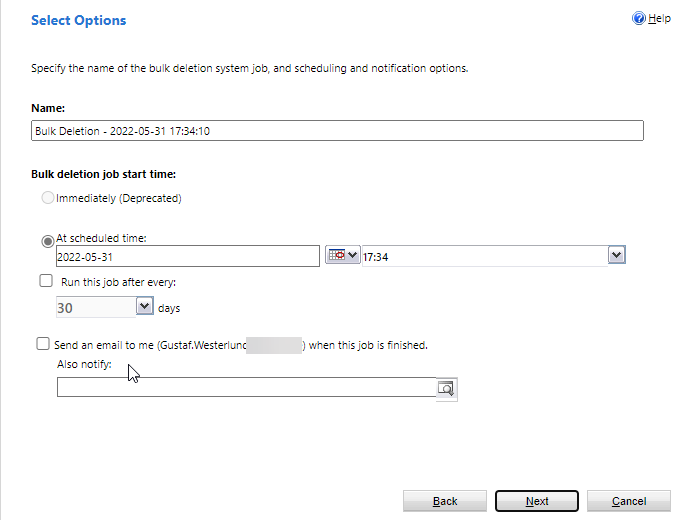
Bulk Delete Manager in XTB
Have you ever tried creating bulk deletes in dataverse/Dynamics 365? It is still a very old interface and it is hard to control the exact definition of what is to be deleted as you cannot see the actual FetchXML that is being used. It is also hard to see existing recurring bulk delete jobs and what FetchXML they are using. Based on these facts, my colleague Ebba Linnea Nilsson and I decided to make our first plugin for XrmToolBox (XTB). We are now proud to announce that it is released and available for free (as usual in XTB). We have also identified a bug in the platform related to this, which I will describe below.
The bulk delete functionality in dataverse and hence in Dynamics 365 CE is an essential function for many organizations. This is especially true since GDPR was introduced and there is a strong legislative requirement to remove personal data that cannot be justified to be stored.
There are also other reasons why the bulk delete functionality is more and more important and that is based on the capacity costs that can be inferred on a Power Platform tennant. Firstly just storing data, especially in the database storage in dataverse has a non trivial cost at $40/GB. There is a lot of value per GB, so it might not be justified to say that it is too expensive but removing unnecessary data is definitely something that can be worthwhile especially for larger implementations. I personally work with a customer in the travel retail industry which has millions of customers and some tables have 40M+ records. There are also a lot of integrations and automations causing a lot of data to be created. Data that at some point needs to be removed. As all data should, or there should at least be a conscious decision not to remove it and why if so.
As you might be aware, if you have read my other articles in this blog, I have previously used SSIS and Kingswaysoft to remove massive amounts of data. However, now that the API Entitlements will be introduced (6 months after the report for API Entitlements is made Generally Available), we need to start to become more and more restrictive in using the APIs for massive data management, like deletes. Hence, we try to move as much as possible to the built in Bulk Delete.
Working with the built in bulk delete functionality is a bit sad. It is very old and you have to click through a wizard kind of experience to be able to set them up. But the most limiting factor is that you cannot see the actual FetchXML of an active recurring bulk delete and you cannot input FetchXML directly into the bulk delete.

Having worked with this wizard you might also have noticed something a bit off. If you create a view which shows all contacts that have no activities. Then this will work when using it in the system like a view. However, if you try to use this view in a bulk delete it will “simplify” this and remove that part of the query. My thought that this was a limitation in the UI based on the fact that it is very old and hasn’t gotten any love for many years (decades). My assumption was hence that creating a bulk delete via the API would allow me to create bulk deletes that were based on FetchXMLs that you couldn’t even input from the UI.
These were the reasons for us starting to create this plugin and it was so useful that I used it in debug mode for several weeks before finalizing it and publishing it.
Now we have released the first version and you can download it directly from XTB. I would like to give a huge thanks to Jonas Rapp who helped us out a lot with both connection to his tool FetchXML Builder but also the general setup of the plugins and the details of getting it approved as a Plugin for XTB.
If you have any suggestions, comments or otherwise, leave them on the GitHub repo https://github.com/crmgustaf/BulkDeleteManager or down below. We already have a bunch of stuff we want to do.
Ah, yes, and the bug we found, it seems that the outer joins that was a rather recent addon to FetchXML is not supported by the actual platform. Hence the UI and the platform match in that perspective. Just to make it clear, what happens is that you input a FetchXML saying “All contacts with no activities” or something like that, which it will simplify to “All contacts” which is not really what you want.

As it is supported to create bulk delete jobs via the API, I do think that this still can be seen as a bug as there is no clear documentation on this or even a control when creating the bulk delete job with a FetchXML that will be incorrectly parsed. My suggestion is hence to implement the new FetchXML parser in Bulk Delete functionality, at least on the platform side. With the current setup, it is very possible that bulk deletes are created that remove a lot more than what was initially intended which can be very damaging to any organization. And from a GDPR perspective, this type of query is rather common, as it might be definied that contacts with no cases can only be stored for 2 years, but with cases for 10. To remove the ones without the cases, you would make the question “Remove all contacts with no cases with created on > 2 years”. This would then cause all contacts with created on > 2 years to be removed regardless of if it has a case or not.
To inform users of this, we have added a warning, every time a new bulk delete job is to be saved. Hopefully Microsoft will fix this soon.

Recent Comments